Workplace Safety and Organizational Practices
VerifiedAdded on 2020/03/15
|18
|4867
|325
AI Summary
This assignment delves into the crucial relationship between workplace safety and organizational practices. It examines various studies and theories that shed light on how organizational policies, leadership styles, and employee perceptions influence safety outcomes. The focus is on understanding the factors contributing to a positive safety culture and identifying best practices for promoting a safe and healthy work environment.
Contribute Materials
Your contribution can guide someone’s learning journey. Share your
documents today.

HUMAN RESOURCE MANAGEMENT 1
HUMAN RESOURCE MANAGEMENT
Name
Tutor
Course
Institutional Affiliation
Date
HUMAN RESOURCE MANAGEMENT
Name
Tutor
Course
Institutional Affiliation
Date
Secure Best Marks with AI Grader
Need help grading? Try our AI Grader for instant feedback on your assignments.

HUMAN RESOURCE MANAGEMENT 2
Executive Summary
The success and high performance of any organization is highly dependent on the
standard of its workforce. Based on this, therefore, organizations should strive to ensure that
their workers are safe and healthy to ensure they work to their full potential. It is further noted
that a workplace environment should give the workers a sense of security where they enjoy safe
physical and psychological environment thus making them more efficient in their roles. Using
the safety challenges of Bruno Smallgoods, the paper has profoundly illustrated the concept of
safety culture and how vital it is to organizational success. The paper has further explained the
responsibilities of the employers in ensuring safe working environment. Based on the findings
of the report, the paper has provided recommendations to Bruno Smallgoods which can be used
to improve the safety of its workplace.
Executive Summary
The success and high performance of any organization is highly dependent on the
standard of its workforce. Based on this, therefore, organizations should strive to ensure that
their workers are safe and healthy to ensure they work to their full potential. It is further noted
that a workplace environment should give the workers a sense of security where they enjoy safe
physical and psychological environment thus making them more efficient in their roles. Using
the safety challenges of Bruno Smallgoods, the paper has profoundly illustrated the concept of
safety culture and how vital it is to organizational success. The paper has further explained the
responsibilities of the employers in ensuring safe working environment. Based on the findings
of the report, the paper has provided recommendations to Bruno Smallgoods which can be used
to improve the safety of its workplace.
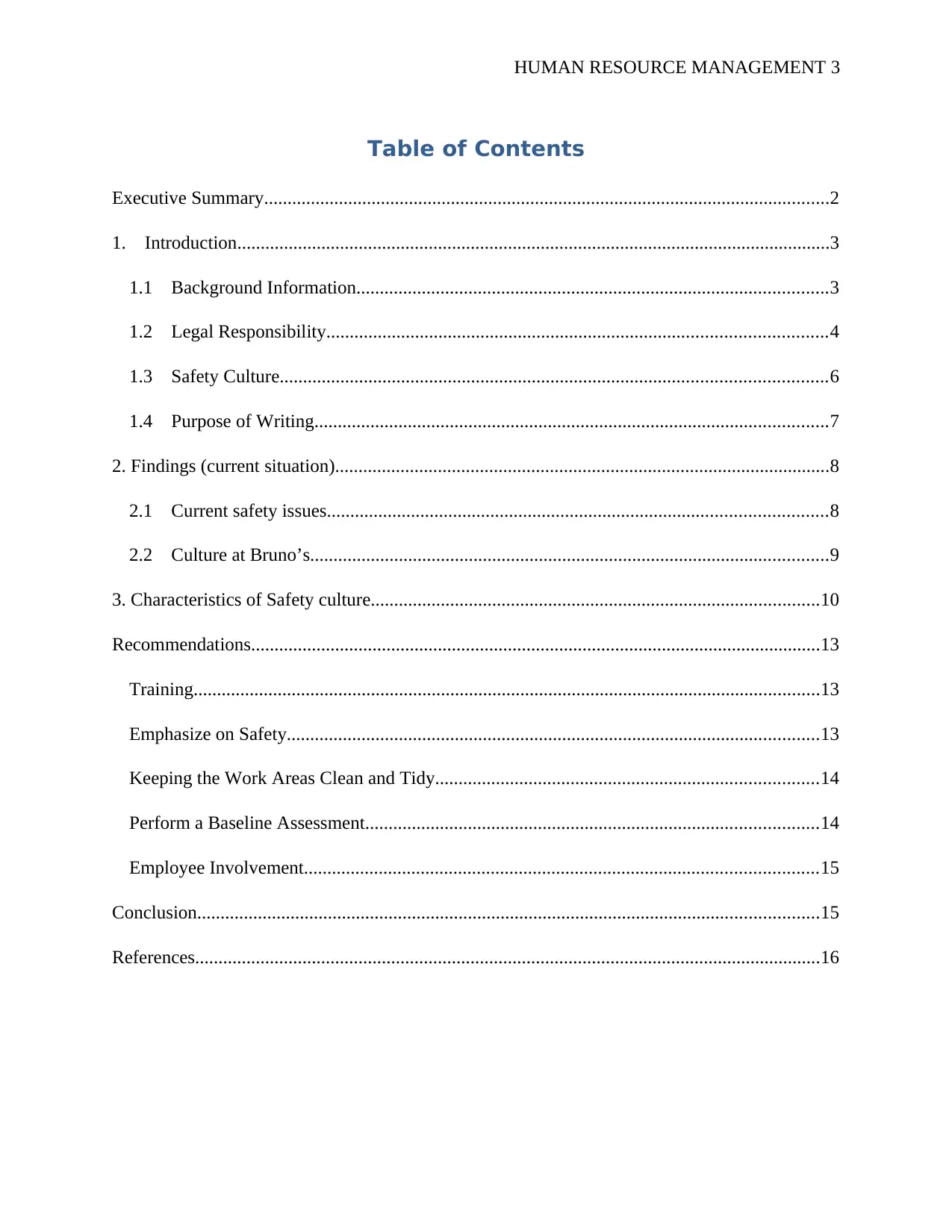
HUMAN RESOURCE MANAGEMENT 3
Table of Contents
Executive Summary.........................................................................................................................2
1. Introduction...............................................................................................................................3
1.1 Background Information.....................................................................................................3
1.2 Legal Responsibility...........................................................................................................4
1.3 Safety Culture.....................................................................................................................6
1.4 Purpose of Writing..............................................................................................................7
2. Findings (current situation)..........................................................................................................8
2.1 Current safety issues...........................................................................................................8
2.2 Culture at Bruno’s...............................................................................................................9
3. Characteristics of Safety culture................................................................................................10
Recommendations..........................................................................................................................13
Training......................................................................................................................................13
Emphasize on Safety..................................................................................................................13
Keeping the Work Areas Clean and Tidy..................................................................................14
Perform a Baseline Assessment.................................................................................................14
Employee Involvement..............................................................................................................15
Conclusion.....................................................................................................................................15
References......................................................................................................................................16
Table of Contents
Executive Summary.........................................................................................................................2
1. Introduction...............................................................................................................................3
1.1 Background Information.....................................................................................................3
1.2 Legal Responsibility...........................................................................................................4
1.3 Safety Culture.....................................................................................................................6
1.4 Purpose of Writing..............................................................................................................7
2. Findings (current situation)..........................................................................................................8
2.1 Current safety issues...........................................................................................................8
2.2 Culture at Bruno’s...............................................................................................................9
3. Characteristics of Safety culture................................................................................................10
Recommendations..........................................................................................................................13
Training......................................................................................................................................13
Emphasize on Safety..................................................................................................................13
Keeping the Work Areas Clean and Tidy..................................................................................14
Perform a Baseline Assessment.................................................................................................14
Employee Involvement..............................................................................................................15
Conclusion.....................................................................................................................................15
References......................................................................................................................................16
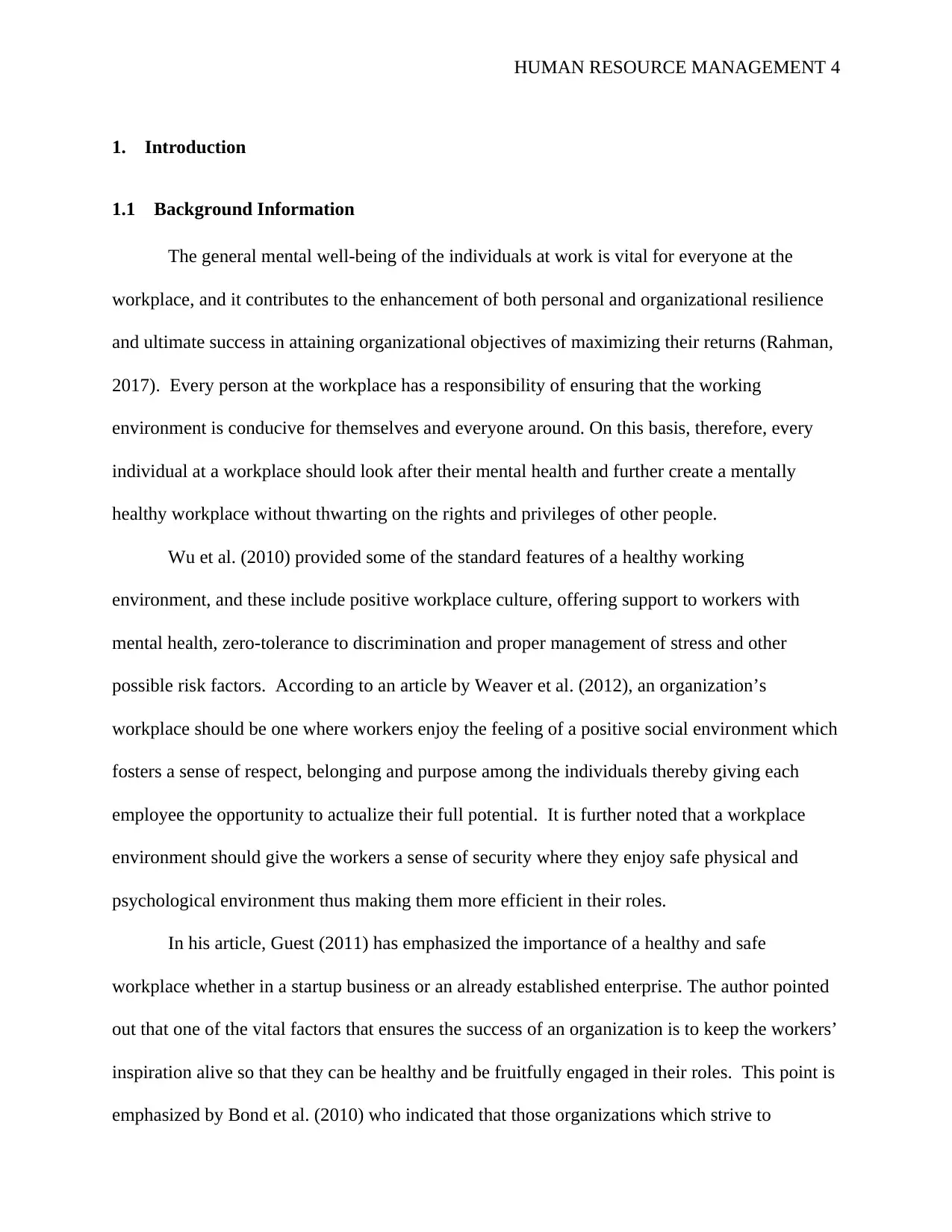
HUMAN RESOURCE MANAGEMENT 4
1. Introduction
1.1 Background Information
The general mental well-being of the individuals at work is vital for everyone at the
workplace, and it contributes to the enhancement of both personal and organizational resilience
and ultimate success in attaining organizational objectives of maximizing their returns (Rahman,
2017). Every person at the workplace has a responsibility of ensuring that the working
environment is conducive for themselves and everyone around. On this basis, therefore, every
individual at a workplace should look after their mental health and further create a mentally
healthy workplace without thwarting on the rights and privileges of other people.
Wu et al. (2010) provided some of the standard features of a healthy working
environment, and these include positive workplace culture, offering support to workers with
mental health, zero-tolerance to discrimination and proper management of stress and other
possible risk factors. According to an article by Weaver et al. (2012), an organization’s
workplace should be one where workers enjoy the feeling of a positive social environment which
fosters a sense of respect, belonging and purpose among the individuals thereby giving each
employee the opportunity to actualize their full potential. It is further noted that a workplace
environment should give the workers a sense of security where they enjoy safe physical and
psychological environment thus making them more efficient in their roles.
In his article, Guest (2011) has emphasized the importance of a healthy and safe
workplace whether in a startup business or an already established enterprise. The author pointed
out that one of the vital factors that ensures the success of an organization is to keep the workers’
inspiration alive so that they can be healthy and be fruitfully engaged in their roles. This point is
emphasized by Bond et al. (2010) who indicated that those organizations which strive to
1. Introduction
1.1 Background Information
The general mental well-being of the individuals at work is vital for everyone at the
workplace, and it contributes to the enhancement of both personal and organizational resilience
and ultimate success in attaining organizational objectives of maximizing their returns (Rahman,
2017). Every person at the workplace has a responsibility of ensuring that the working
environment is conducive for themselves and everyone around. On this basis, therefore, every
individual at a workplace should look after their mental health and further create a mentally
healthy workplace without thwarting on the rights and privileges of other people.
Wu et al. (2010) provided some of the standard features of a healthy working
environment, and these include positive workplace culture, offering support to workers with
mental health, zero-tolerance to discrimination and proper management of stress and other
possible risk factors. According to an article by Weaver et al. (2012), an organization’s
workplace should be one where workers enjoy the feeling of a positive social environment which
fosters a sense of respect, belonging and purpose among the individuals thereby giving each
employee the opportunity to actualize their full potential. It is further noted that a workplace
environment should give the workers a sense of security where they enjoy safe physical and
psychological environment thus making them more efficient in their roles.
In his article, Guest (2011) has emphasized the importance of a healthy and safe
workplace whether in a startup business or an already established enterprise. The author pointed
out that one of the vital factors that ensures the success of an organization is to keep the workers’
inspiration alive so that they can be healthy and be fruitfully engaged in their roles. This point is
emphasized by Bond et al. (2010) who indicated that those organizations which strive to
Secure Best Marks with AI Grader
Need help grading? Try our AI Grader for instant feedback on your assignments.
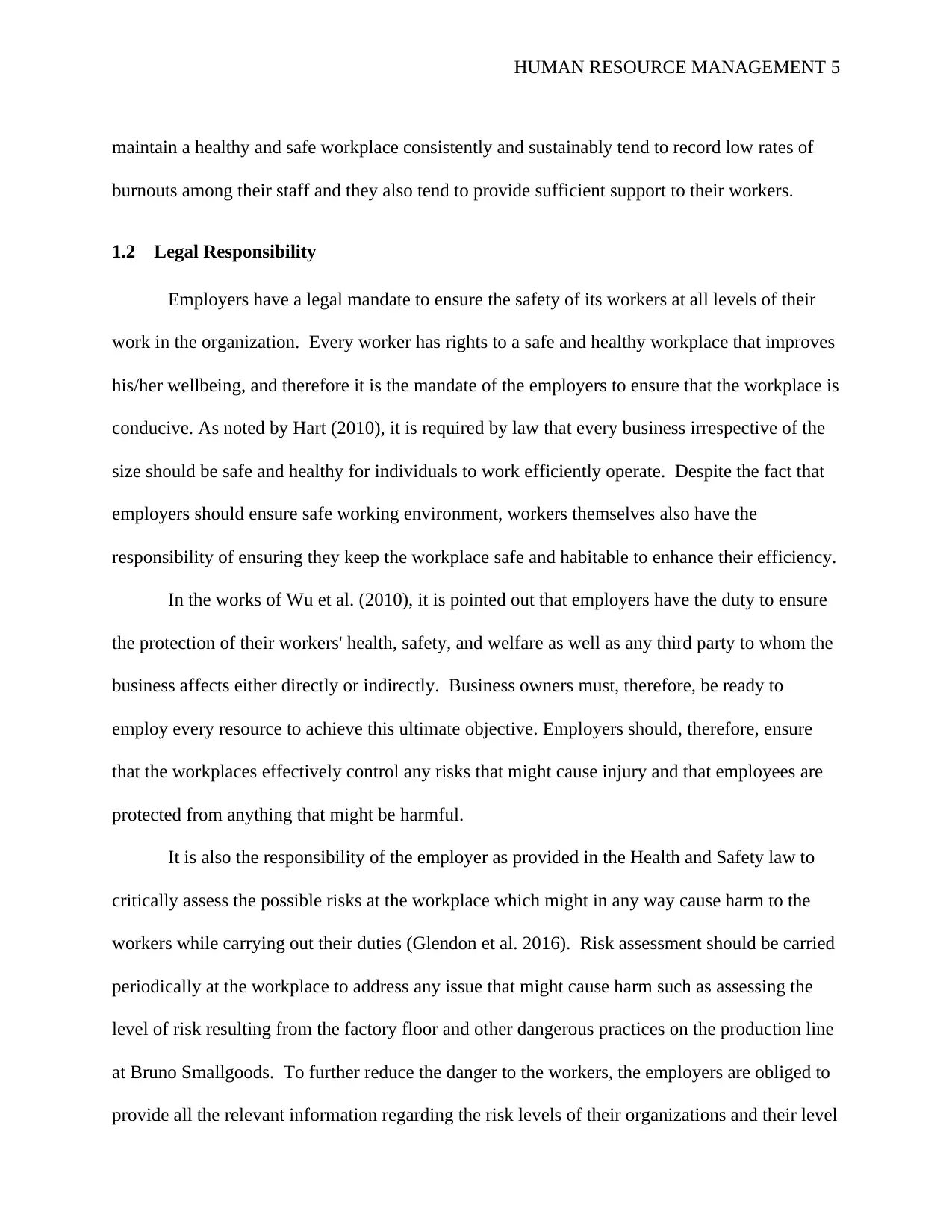
HUMAN RESOURCE MANAGEMENT 5
maintain a healthy and safe workplace consistently and sustainably tend to record low rates of
burnouts among their staff and they also tend to provide sufficient support to their workers.
1.2 Legal Responsibility
Employers have a legal mandate to ensure the safety of its workers at all levels of their
work in the organization. Every worker has rights to a safe and healthy workplace that improves
his/her wellbeing, and therefore it is the mandate of the employers to ensure that the workplace is
conducive. As noted by Hart (2010), it is required by law that every business irrespective of the
size should be safe and healthy for individuals to work efficiently operate. Despite the fact that
employers should ensure safe working environment, workers themselves also have the
responsibility of ensuring they keep the workplace safe and habitable to enhance their efficiency.
In the works of Wu et al. (2010), it is pointed out that employers have the duty to ensure
the protection of their workers' health, safety, and welfare as well as any third party to whom the
business affects either directly or indirectly. Business owners must, therefore, be ready to
employ every resource to achieve this ultimate objective. Employers should, therefore, ensure
that the workplaces effectively control any risks that might cause injury and that employees are
protected from anything that might be harmful.
It is also the responsibility of the employer as provided in the Health and Safety law to
critically assess the possible risks at the workplace which might in any way cause harm to the
workers while carrying out their duties (Glendon et al. 2016). Risk assessment should be carried
periodically at the workplace to address any issue that might cause harm such as assessing the
level of risk resulting from the factory floor and other dangerous practices on the production line
at Bruno Smallgoods. To further reduce the danger to the workers, the employers are obliged to
provide all the relevant information regarding the risk levels of their organizations and their level
maintain a healthy and safe workplace consistently and sustainably tend to record low rates of
burnouts among their staff and they also tend to provide sufficient support to their workers.
1.2 Legal Responsibility
Employers have a legal mandate to ensure the safety of its workers at all levels of their
work in the organization. Every worker has rights to a safe and healthy workplace that improves
his/her wellbeing, and therefore it is the mandate of the employers to ensure that the workplace is
conducive. As noted by Hart (2010), it is required by law that every business irrespective of the
size should be safe and healthy for individuals to work efficiently operate. Despite the fact that
employers should ensure safe working environment, workers themselves also have the
responsibility of ensuring they keep the workplace safe and habitable to enhance their efficiency.
In the works of Wu et al. (2010), it is pointed out that employers have the duty to ensure
the protection of their workers' health, safety, and welfare as well as any third party to whom the
business affects either directly or indirectly. Business owners must, therefore, be ready to
employ every resource to achieve this ultimate objective. Employers should, therefore, ensure
that the workplaces effectively control any risks that might cause injury and that employees are
protected from anything that might be harmful.
It is also the responsibility of the employer as provided in the Health and Safety law to
critically assess the possible risks at the workplace which might in any way cause harm to the
workers while carrying out their duties (Glendon et al. 2016). Risk assessment should be carried
periodically at the workplace to address any issue that might cause harm such as assessing the
level of risk resulting from the factory floor and other dangerous practices on the production line
at Bruno Smallgoods. To further reduce the danger to the workers, the employers are obliged to
provide all the relevant information regarding the risk levels of their organizations and their level
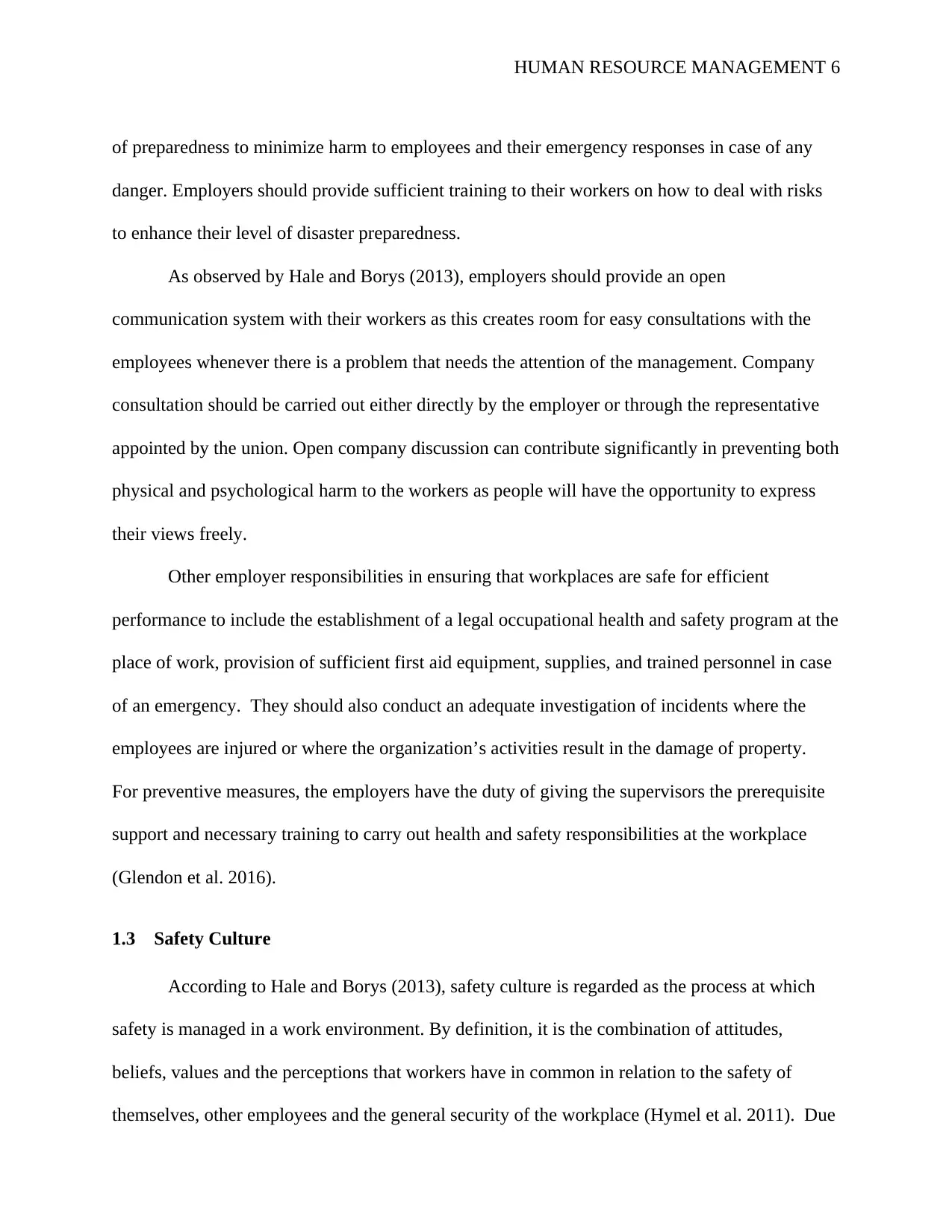
HUMAN RESOURCE MANAGEMENT 6
of preparedness to minimize harm to employees and their emergency responses in case of any
danger. Employers should provide sufficient training to their workers on how to deal with risks
to enhance their level of disaster preparedness.
As observed by Hale and Borys (2013), employers should provide an open
communication system with their workers as this creates room for easy consultations with the
employees whenever there is a problem that needs the attention of the management. Company
consultation should be carried out either directly by the employer or through the representative
appointed by the union. Open company discussion can contribute significantly in preventing both
physical and psychological harm to the workers as people will have the opportunity to express
their views freely.
Other employer responsibilities in ensuring that workplaces are safe for efficient
performance to include the establishment of a legal occupational health and safety program at the
place of work, provision of sufficient first aid equipment, supplies, and trained personnel in case
of an emergency. They should also conduct an adequate investigation of incidents where the
employees are injured or where the organization’s activities result in the damage of property.
For preventive measures, the employers have the duty of giving the supervisors the prerequisite
support and necessary training to carry out health and safety responsibilities at the workplace
(Glendon et al. 2016).
1.3 Safety Culture
According to Hale and Borys (2013), safety culture is regarded as the process at which
safety is managed in a work environment. By definition, it is the combination of attitudes,
beliefs, values and the perceptions that workers have in common in relation to the safety of
themselves, other employees and the general security of the workplace (Hymel et al. 2011). Due
of preparedness to minimize harm to employees and their emergency responses in case of any
danger. Employers should provide sufficient training to their workers on how to deal with risks
to enhance their level of disaster preparedness.
As observed by Hale and Borys (2013), employers should provide an open
communication system with their workers as this creates room for easy consultations with the
employees whenever there is a problem that needs the attention of the management. Company
consultation should be carried out either directly by the employer or through the representative
appointed by the union. Open company discussion can contribute significantly in preventing both
physical and psychological harm to the workers as people will have the opportunity to express
their views freely.
Other employer responsibilities in ensuring that workplaces are safe for efficient
performance to include the establishment of a legal occupational health and safety program at the
place of work, provision of sufficient first aid equipment, supplies, and trained personnel in case
of an emergency. They should also conduct an adequate investigation of incidents where the
employees are injured or where the organization’s activities result in the damage of property.
For preventive measures, the employers have the duty of giving the supervisors the prerequisite
support and necessary training to carry out health and safety responsibilities at the workplace
(Glendon et al. 2016).
1.3 Safety Culture
According to Hale and Borys (2013), safety culture is regarded as the process at which
safety is managed in a work environment. By definition, it is the combination of attitudes,
beliefs, values and the perceptions that workers have in common in relation to the safety of
themselves, other employees and the general security of the workplace (Hymel et al. 2011). Due
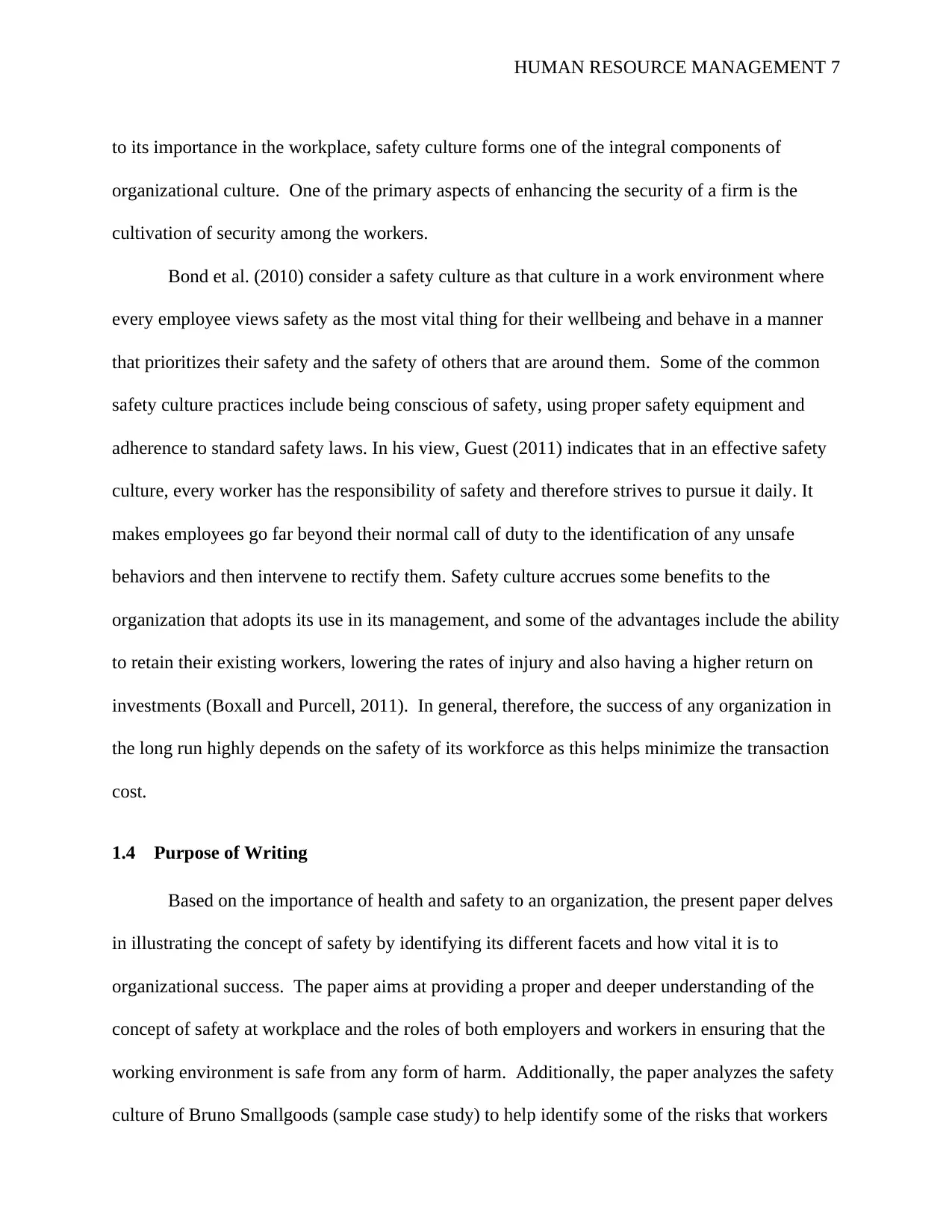
HUMAN RESOURCE MANAGEMENT 7
to its importance in the workplace, safety culture forms one of the integral components of
organizational culture. One of the primary aspects of enhancing the security of a firm is the
cultivation of security among the workers.
Bond et al. (2010) consider a safety culture as that culture in a work environment where
every employee views safety as the most vital thing for their wellbeing and behave in a manner
that prioritizes their safety and the safety of others that are around them. Some of the common
safety culture practices include being conscious of safety, using proper safety equipment and
adherence to standard safety laws. In his view, Guest (2011) indicates that in an effective safety
culture, every worker has the responsibility of safety and therefore strives to pursue it daily. It
makes employees go far beyond their normal call of duty to the identification of any unsafe
behaviors and then intervene to rectify them. Safety culture accrues some benefits to the
organization that adopts its use in its management, and some of the advantages include the ability
to retain their existing workers, lowering the rates of injury and also having a higher return on
investments (Boxall and Purcell, 2011). In general, therefore, the success of any organization in
the long run highly depends on the safety of its workforce as this helps minimize the transaction
cost.
1.4 Purpose of Writing
Based on the importance of health and safety to an organization, the present paper delves
in illustrating the concept of safety by identifying its different facets and how vital it is to
organizational success. The paper aims at providing a proper and deeper understanding of the
concept of safety at workplace and the roles of both employers and workers in ensuring that the
working environment is safe from any form of harm. Additionally, the paper analyzes the safety
culture of Bruno Smallgoods (sample case study) to help identify some of the risks that workers
to its importance in the workplace, safety culture forms one of the integral components of
organizational culture. One of the primary aspects of enhancing the security of a firm is the
cultivation of security among the workers.
Bond et al. (2010) consider a safety culture as that culture in a work environment where
every employee views safety as the most vital thing for their wellbeing and behave in a manner
that prioritizes their safety and the safety of others that are around them. Some of the common
safety culture practices include being conscious of safety, using proper safety equipment and
adherence to standard safety laws. In his view, Guest (2011) indicates that in an effective safety
culture, every worker has the responsibility of safety and therefore strives to pursue it daily. It
makes employees go far beyond their normal call of duty to the identification of any unsafe
behaviors and then intervene to rectify them. Safety culture accrues some benefits to the
organization that adopts its use in its management, and some of the advantages include the ability
to retain their existing workers, lowering the rates of injury and also having a higher return on
investments (Boxall and Purcell, 2011). In general, therefore, the success of any organization in
the long run highly depends on the safety of its workforce as this helps minimize the transaction
cost.
1.4 Purpose of Writing
Based on the importance of health and safety to an organization, the present paper delves
in illustrating the concept of safety by identifying its different facets and how vital it is to
organizational success. The paper aims at providing a proper and deeper understanding of the
concept of safety at workplace and the roles of both employers and workers in ensuring that the
working environment is safe from any form of harm. Additionally, the paper analyzes the safety
culture of Bruno Smallgoods (sample case study) to help identify some of the risks that workers
Paraphrase This Document
Need a fresh take? Get an instant paraphrase of this document with our AI Paraphraser
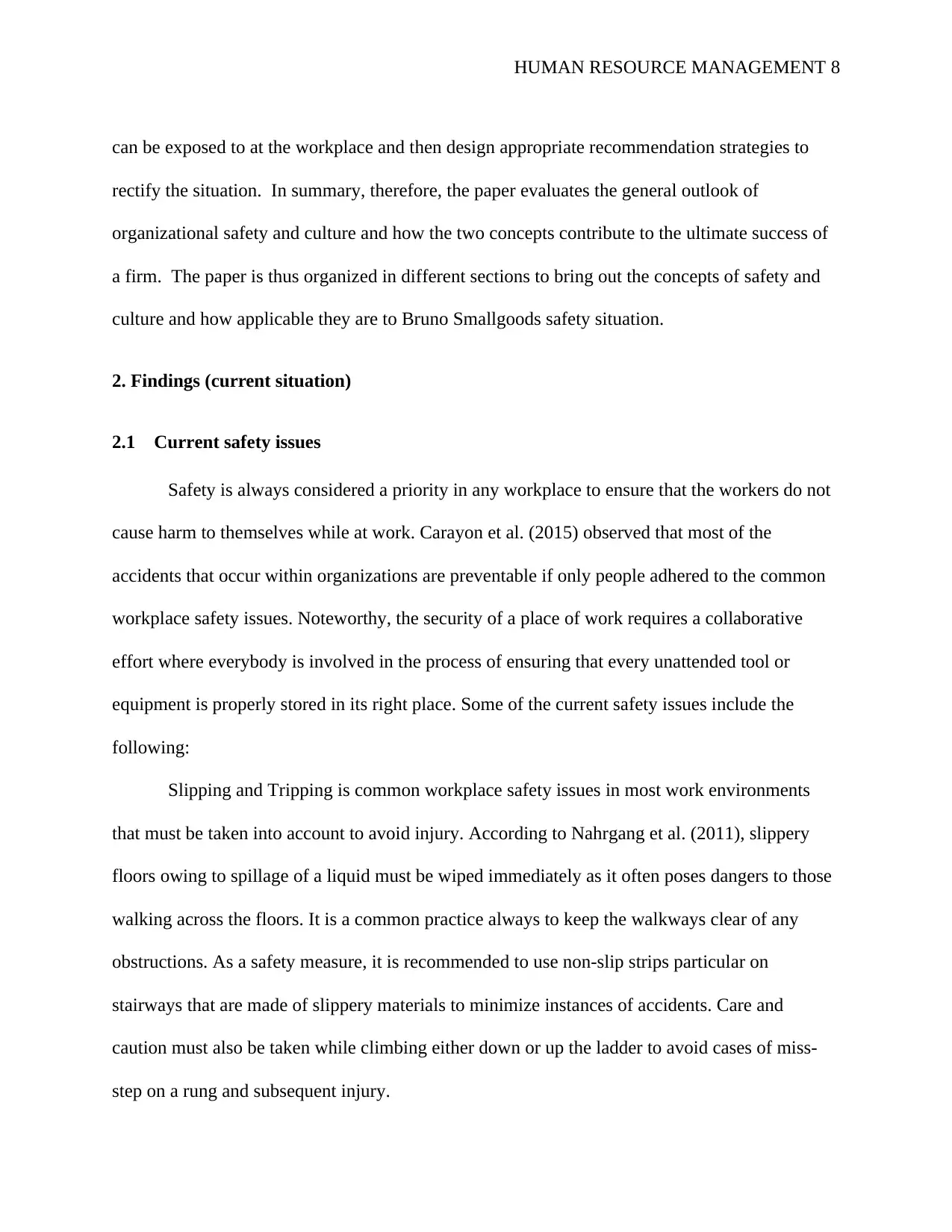
HUMAN RESOURCE MANAGEMENT 8
can be exposed to at the workplace and then design appropriate recommendation strategies to
rectify the situation. In summary, therefore, the paper evaluates the general outlook of
organizational safety and culture and how the two concepts contribute to the ultimate success of
a firm. The paper is thus organized in different sections to bring out the concepts of safety and
culture and how applicable they are to Bruno Smallgoods safety situation.
2. Findings (current situation)
2.1 Current safety issues
Safety is always considered a priority in any workplace to ensure that the workers do not
cause harm to themselves while at work. Carayon et al. (2015) observed that most of the
accidents that occur within organizations are preventable if only people adhered to the common
workplace safety issues. Noteworthy, the security of a place of work requires a collaborative
effort where everybody is involved in the process of ensuring that every unattended tool or
equipment is properly stored in its right place. Some of the current safety issues include the
following:
Slipping and Tripping is common workplace safety issues in most work environments
that must be taken into account to avoid injury. According to Nahrgang et al. (2011), slippery
floors owing to spillage of a liquid must be wiped immediately as it often poses dangers to those
walking across the floors. It is a common practice always to keep the walkways clear of any
obstructions. As a safety measure, it is recommended to use non-slip strips particular on
stairways that are made of slippery materials to minimize instances of accidents. Care and
caution must also be taken while climbing either down or up the ladder to avoid cases of miss-
step on a rung and subsequent injury.
can be exposed to at the workplace and then design appropriate recommendation strategies to
rectify the situation. In summary, therefore, the paper evaluates the general outlook of
organizational safety and culture and how the two concepts contribute to the ultimate success of
a firm. The paper is thus organized in different sections to bring out the concepts of safety and
culture and how applicable they are to Bruno Smallgoods safety situation.
2. Findings (current situation)
2.1 Current safety issues
Safety is always considered a priority in any workplace to ensure that the workers do not
cause harm to themselves while at work. Carayon et al. (2015) observed that most of the
accidents that occur within organizations are preventable if only people adhered to the common
workplace safety issues. Noteworthy, the security of a place of work requires a collaborative
effort where everybody is involved in the process of ensuring that every unattended tool or
equipment is properly stored in its right place. Some of the current safety issues include the
following:
Slipping and Tripping is common workplace safety issues in most work environments
that must be taken into account to avoid injury. According to Nahrgang et al. (2011), slippery
floors owing to spillage of a liquid must be wiped immediately as it often poses dangers to those
walking across the floors. It is a common practice always to keep the walkways clear of any
obstructions. As a safety measure, it is recommended to use non-slip strips particular on
stairways that are made of slippery materials to minimize instances of accidents. Care and
caution must also be taken while climbing either down or up the ladder to avoid cases of miss-
step on a rung and subsequent injury.
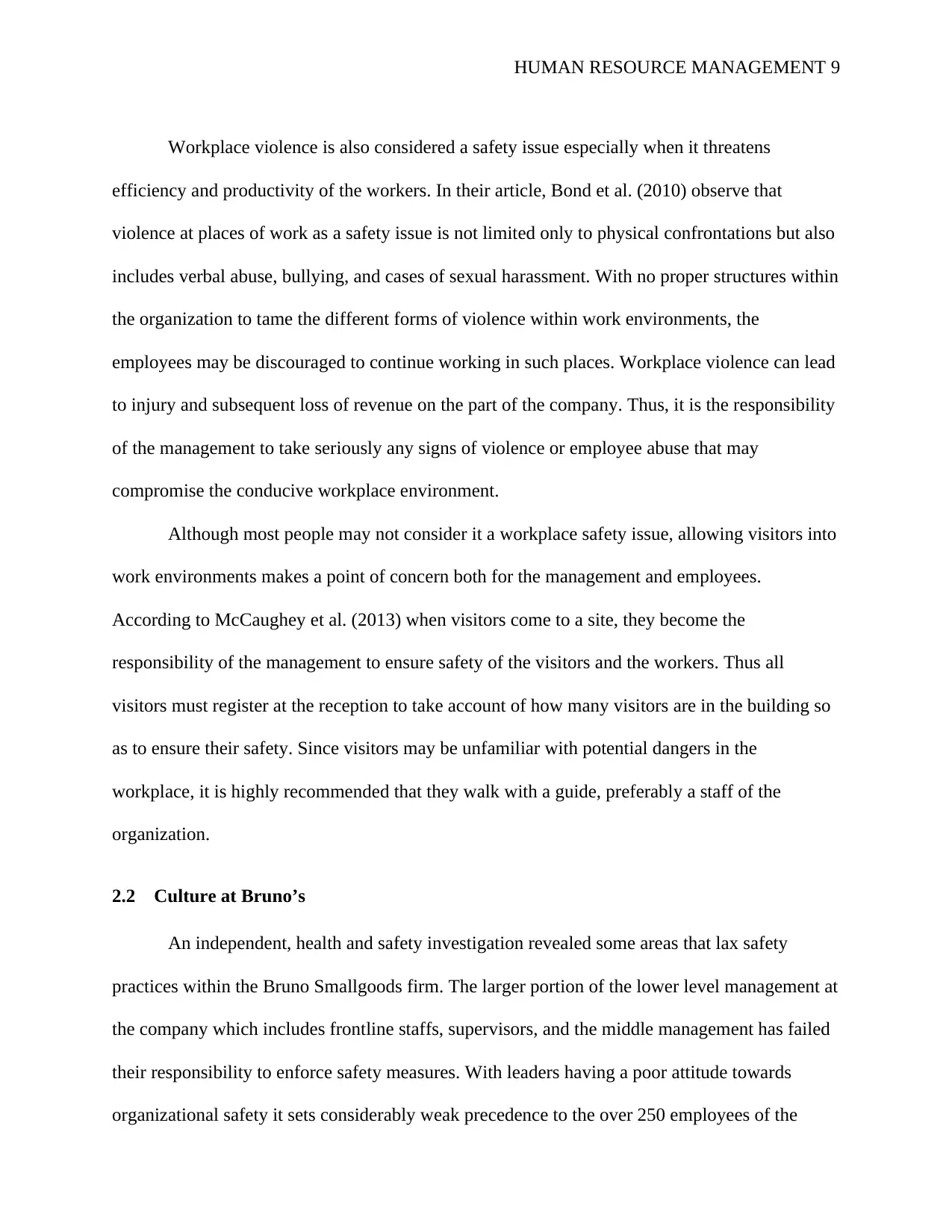
HUMAN RESOURCE MANAGEMENT 9
Workplace violence is also considered a safety issue especially when it threatens
efficiency and productivity of the workers. In their article, Bond et al. (2010) observe that
violence at places of work as a safety issue is not limited only to physical confrontations but also
includes verbal abuse, bullying, and cases of sexual harassment. With no proper structures within
the organization to tame the different forms of violence within work environments, the
employees may be discouraged to continue working in such places. Workplace violence can lead
to injury and subsequent loss of revenue on the part of the company. Thus, it is the responsibility
of the management to take seriously any signs of violence or employee abuse that may
compromise the conducive workplace environment.
Although most people may not consider it a workplace safety issue, allowing visitors into
work environments makes a point of concern both for the management and employees.
According to McCaughey et al. (2013) when visitors come to a site, they become the
responsibility of the management to ensure safety of the visitors and the workers. Thus all
visitors must register at the reception to take account of how many visitors are in the building so
as to ensure their safety. Since visitors may be unfamiliar with potential dangers in the
workplace, it is highly recommended that they walk with a guide, preferably a staff of the
organization.
2.2 Culture at Bruno’s
An independent, health and safety investigation revealed some areas that lax safety
practices within the Bruno Smallgoods firm. The larger portion of the lower level management at
the company which includes frontline staffs, supervisors, and the middle management has failed
their responsibility to enforce safety measures. With leaders having a poor attitude towards
organizational safety it sets considerably weak precedence to the over 250 employees of the
Workplace violence is also considered a safety issue especially when it threatens
efficiency and productivity of the workers. In their article, Bond et al. (2010) observe that
violence at places of work as a safety issue is not limited only to physical confrontations but also
includes verbal abuse, bullying, and cases of sexual harassment. With no proper structures within
the organization to tame the different forms of violence within work environments, the
employees may be discouraged to continue working in such places. Workplace violence can lead
to injury and subsequent loss of revenue on the part of the company. Thus, it is the responsibility
of the management to take seriously any signs of violence or employee abuse that may
compromise the conducive workplace environment.
Although most people may not consider it a workplace safety issue, allowing visitors into
work environments makes a point of concern both for the management and employees.
According to McCaughey et al. (2013) when visitors come to a site, they become the
responsibility of the management to ensure safety of the visitors and the workers. Thus all
visitors must register at the reception to take account of how many visitors are in the building so
as to ensure their safety. Since visitors may be unfamiliar with potential dangers in the
workplace, it is highly recommended that they walk with a guide, preferably a staff of the
organization.
2.2 Culture at Bruno’s
An independent, health and safety investigation revealed some areas that lax safety
practices within the Bruno Smallgoods firm. The larger portion of the lower level management at
the company which includes frontline staffs, supervisors, and the middle management has failed
their responsibility to enforce safety measures. With leaders having a poor attitude towards
organizational safety it sets considerably weak precedence to the over 250 employees of the
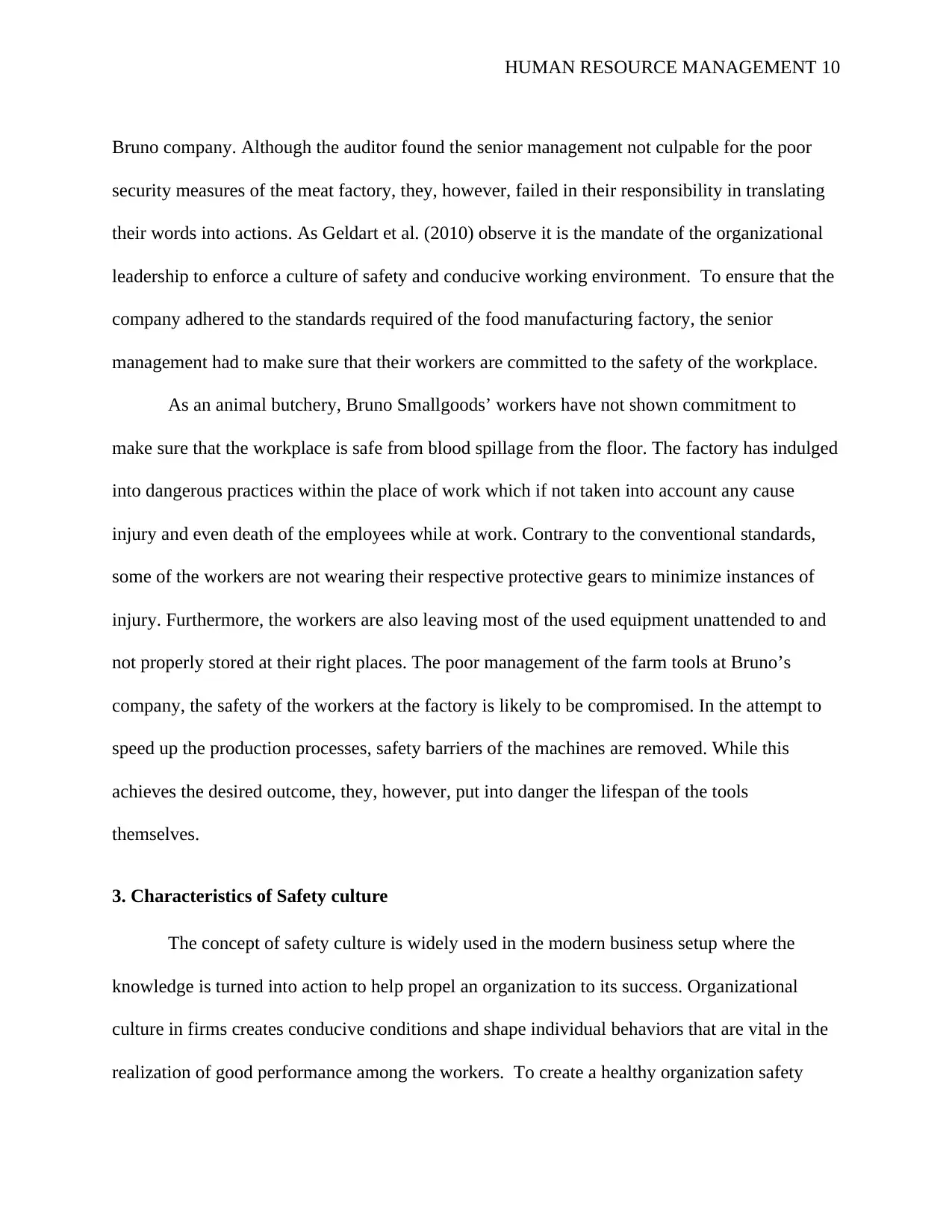
HUMAN RESOURCE MANAGEMENT 10
Bruno company. Although the auditor found the senior management not culpable for the poor
security measures of the meat factory, they, however, failed in their responsibility in translating
their words into actions. As Geldart et al. (2010) observe it is the mandate of the organizational
leadership to enforce a culture of safety and conducive working environment. To ensure that the
company adhered to the standards required of the food manufacturing factory, the senior
management had to make sure that their workers are committed to the safety of the workplace.
As an animal butchery, Bruno Smallgoods’ workers have not shown commitment to
make sure that the workplace is safe from blood spillage from the floor. The factory has indulged
into dangerous practices within the place of work which if not taken into account any cause
injury and even death of the employees while at work. Contrary to the conventional standards,
some of the workers are not wearing their respective protective gears to minimize instances of
injury. Furthermore, the workers are also leaving most of the used equipment unattended to and
not properly stored at their right places. The poor management of the farm tools at Bruno’s
company, the safety of the workers at the factory is likely to be compromised. In the attempt to
speed up the production processes, safety barriers of the machines are removed. While this
achieves the desired outcome, they, however, put into danger the lifespan of the tools
themselves.
3. Characteristics of Safety culture
The concept of safety culture is widely used in the modern business setup where the
knowledge is turned into action to help propel an organization to its success. Organizational
culture in firms creates conducive conditions and shape individual behaviors that are vital in the
realization of good performance among the workers. To create a healthy organization safety
Bruno company. Although the auditor found the senior management not culpable for the poor
security measures of the meat factory, they, however, failed in their responsibility in translating
their words into actions. As Geldart et al. (2010) observe it is the mandate of the organizational
leadership to enforce a culture of safety and conducive working environment. To ensure that the
company adhered to the standards required of the food manufacturing factory, the senior
management had to make sure that their workers are committed to the safety of the workplace.
As an animal butchery, Bruno Smallgoods’ workers have not shown commitment to
make sure that the workplace is safe from blood spillage from the floor. The factory has indulged
into dangerous practices within the place of work which if not taken into account any cause
injury and even death of the employees while at work. Contrary to the conventional standards,
some of the workers are not wearing their respective protective gears to minimize instances of
injury. Furthermore, the workers are also leaving most of the used equipment unattended to and
not properly stored at their right places. The poor management of the farm tools at Bruno’s
company, the safety of the workers at the factory is likely to be compromised. In the attempt to
speed up the production processes, safety barriers of the machines are removed. While this
achieves the desired outcome, they, however, put into danger the lifespan of the tools
themselves.
3. Characteristics of Safety culture
The concept of safety culture is widely used in the modern business setup where the
knowledge is turned into action to help propel an organization to its success. Organizational
culture in firms creates conducive conditions and shape individual behaviors that are vital in the
realization of good performance among the workers. To create a healthy organization safety
Secure Best Marks with AI Grader
Need help grading? Try our AI Grader for instant feedback on your assignments.
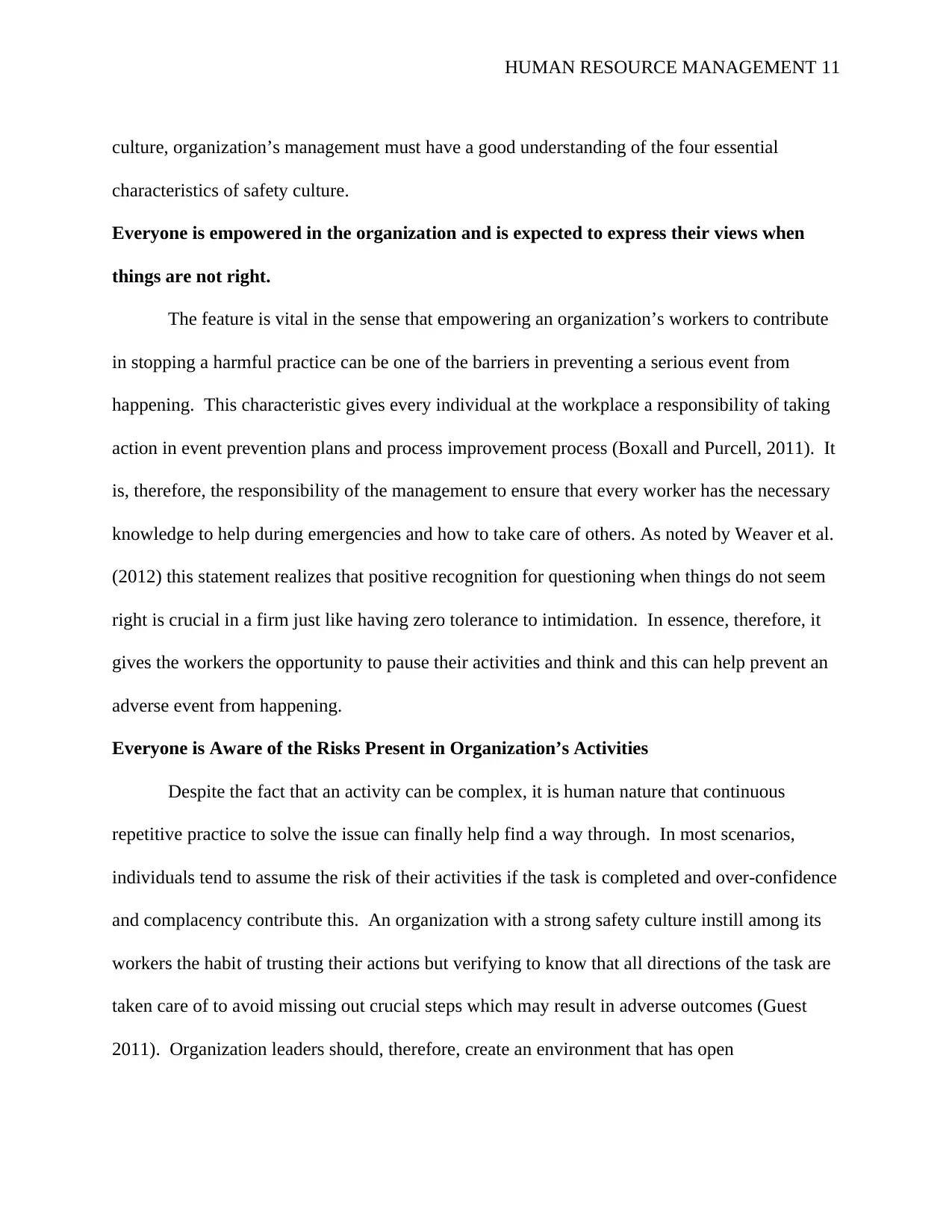
HUMAN RESOURCE MANAGEMENT 11
culture, organization’s management must have a good understanding of the four essential
characteristics of safety culture.
Everyone is empowered in the organization and is expected to express their views when
things are not right.
The feature is vital in the sense that empowering an organization’s workers to contribute
in stopping a harmful practice can be one of the barriers in preventing a serious event from
happening. This characteristic gives every individual at the workplace a responsibility of taking
action in event prevention plans and process improvement process (Boxall and Purcell, 2011). It
is, therefore, the responsibility of the management to ensure that every worker has the necessary
knowledge to help during emergencies and how to take care of others. As noted by Weaver et al.
(2012) this statement realizes that positive recognition for questioning when things do not seem
right is crucial in a firm just like having zero tolerance to intimidation. In essence, therefore, it
gives the workers the opportunity to pause their activities and think and this can help prevent an
adverse event from happening.
Everyone is Aware of the Risks Present in Organization’s Activities
Despite the fact that an activity can be complex, it is human nature that continuous
repetitive practice to solve the issue can finally help find a way through. In most scenarios,
individuals tend to assume the risk of their activities if the task is completed and over-confidence
and complacency contribute this. An organization with a strong safety culture instill among its
workers the habit of trusting their actions but verifying to know that all directions of the task are
taken care of to avoid missing out crucial steps which may result in adverse outcomes (Guest
2011). Organization leaders should, therefore, create an environment that has open
culture, organization’s management must have a good understanding of the four essential
characteristics of safety culture.
Everyone is empowered in the organization and is expected to express their views when
things are not right.
The feature is vital in the sense that empowering an organization’s workers to contribute
in stopping a harmful practice can be one of the barriers in preventing a serious event from
happening. This characteristic gives every individual at the workplace a responsibility of taking
action in event prevention plans and process improvement process (Boxall and Purcell, 2011). It
is, therefore, the responsibility of the management to ensure that every worker has the necessary
knowledge to help during emergencies and how to take care of others. As noted by Weaver et al.
(2012) this statement realizes that positive recognition for questioning when things do not seem
right is crucial in a firm just like having zero tolerance to intimidation. In essence, therefore, it
gives the workers the opportunity to pause their activities and think and this can help prevent an
adverse event from happening.
Everyone is Aware of the Risks Present in Organization’s Activities
Despite the fact that an activity can be complex, it is human nature that continuous
repetitive practice to solve the issue can finally help find a way through. In most scenarios,
individuals tend to assume the risk of their activities if the task is completed and over-confidence
and complacency contribute this. An organization with a strong safety culture instill among its
workers the habit of trusting their actions but verifying to know that all directions of the task are
taken care of to avoid missing out crucial steps which may result in adverse outcomes (Guest
2011). Organization leaders should, therefore, create an environment that has open
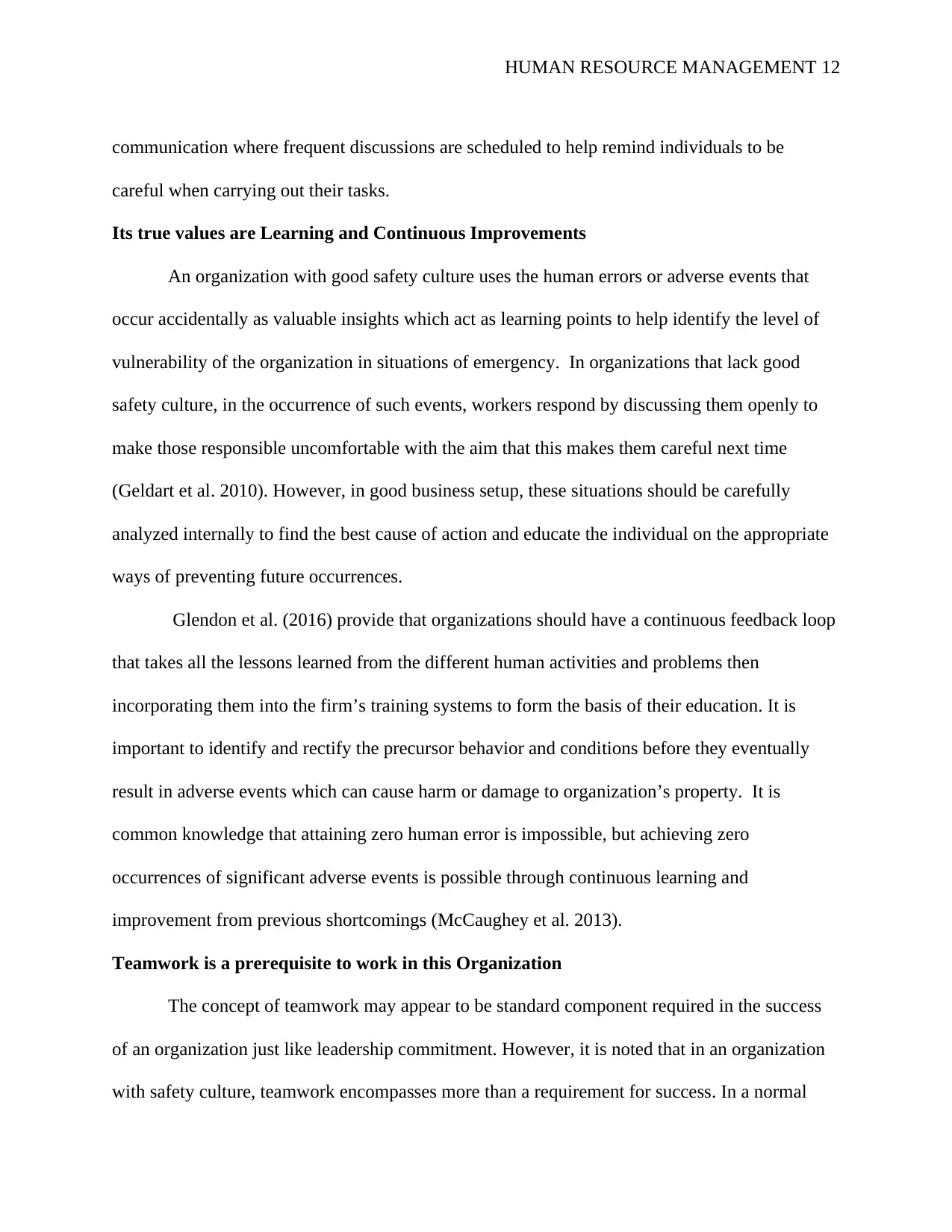
HUMAN RESOURCE MANAGEMENT 12
communication where frequent discussions are scheduled to help remind individuals to be
careful when carrying out their tasks.
Its true values are Learning and Continuous Improvements
An organization with good safety culture uses the human errors or adverse events that
occur accidentally as valuable insights which act as learning points to help identify the level of
vulnerability of the organization in situations of emergency. In organizations that lack good
safety culture, in the occurrence of such events, workers respond by discussing them openly to
make those responsible uncomfortable with the aim that this makes them careful next time
(Geldart et al. 2010). However, in good business setup, these situations should be carefully
analyzed internally to find the best cause of action and educate the individual on the appropriate
ways of preventing future occurrences.
Glendon et al. (2016) provide that organizations should have a continuous feedback loop
that takes all the lessons learned from the different human activities and problems then
incorporating them into the firm’s training systems to form the basis of their education. It is
important to identify and rectify the precursor behavior and conditions before they eventually
result in adverse events which can cause harm or damage to organization’s property. It is
common knowledge that attaining zero human error is impossible, but achieving zero
occurrences of significant adverse events is possible through continuous learning and
improvement from previous shortcomings (McCaughey et al. 2013).
Teamwork is a prerequisite to work in this Organization
The concept of teamwork may appear to be standard component required in the success
of an organization just like leadership commitment. However, it is noted that in an organization
with safety culture, teamwork encompasses more than a requirement for success. In a normal
communication where frequent discussions are scheduled to help remind individuals to be
careful when carrying out their tasks.
Its true values are Learning and Continuous Improvements
An organization with good safety culture uses the human errors or adverse events that
occur accidentally as valuable insights which act as learning points to help identify the level of
vulnerability of the organization in situations of emergency. In organizations that lack good
safety culture, in the occurrence of such events, workers respond by discussing them openly to
make those responsible uncomfortable with the aim that this makes them careful next time
(Geldart et al. 2010). However, in good business setup, these situations should be carefully
analyzed internally to find the best cause of action and educate the individual on the appropriate
ways of preventing future occurrences.
Glendon et al. (2016) provide that organizations should have a continuous feedback loop
that takes all the lessons learned from the different human activities and problems then
incorporating them into the firm’s training systems to form the basis of their education. It is
important to identify and rectify the precursor behavior and conditions before they eventually
result in adverse events which can cause harm or damage to organization’s property. It is
common knowledge that attaining zero human error is impossible, but achieving zero
occurrences of significant adverse events is possible through continuous learning and
improvement from previous shortcomings (McCaughey et al. 2013).
Teamwork is a prerequisite to work in this Organization
The concept of teamwork may appear to be standard component required in the success
of an organization just like leadership commitment. However, it is noted that in an organization
with safety culture, teamwork encompasses more than a requirement for success. In a normal
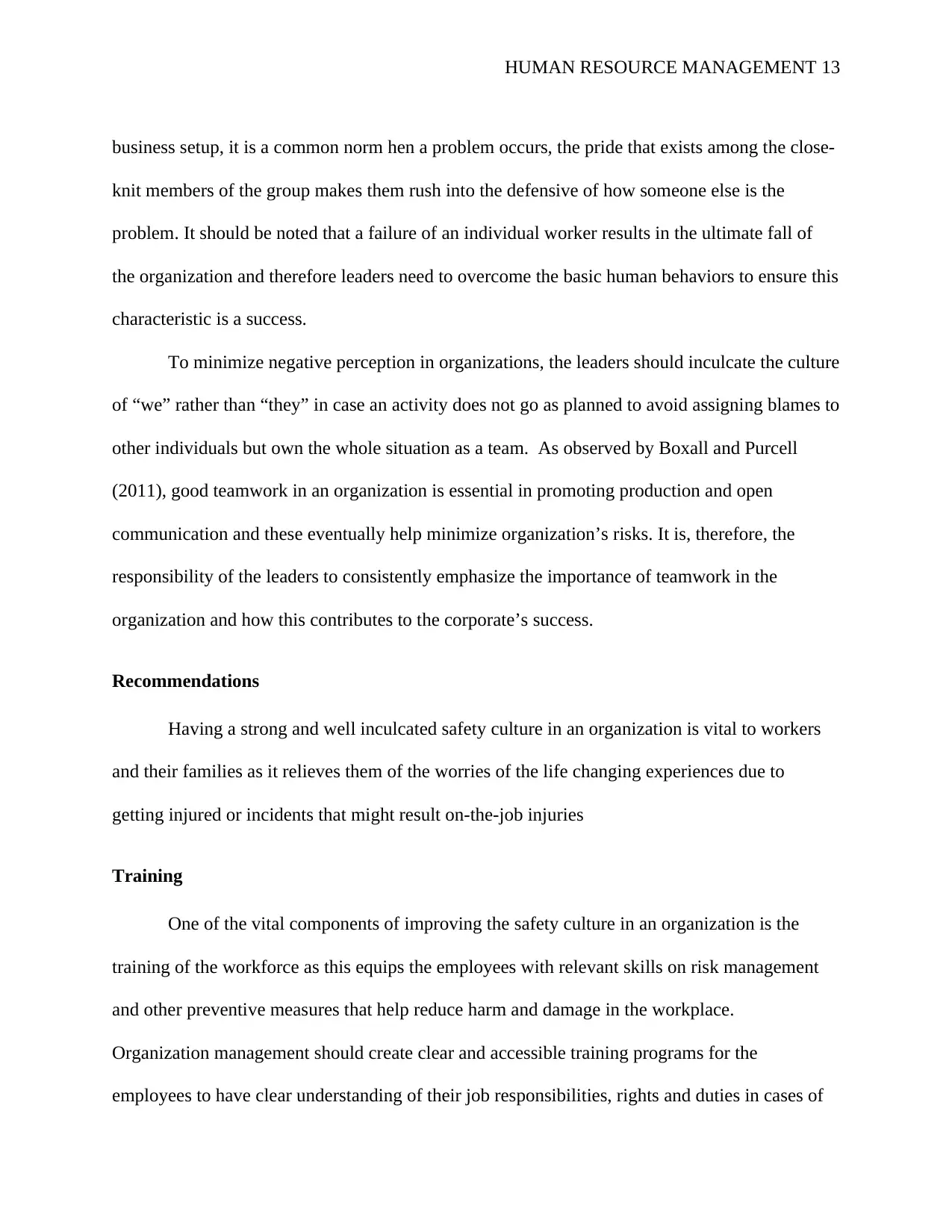
HUMAN RESOURCE MANAGEMENT 13
business setup, it is a common norm hen a problem occurs, the pride that exists among the close-
knit members of the group makes them rush into the defensive of how someone else is the
problem. It should be noted that a failure of an individual worker results in the ultimate fall of
the organization and therefore leaders need to overcome the basic human behaviors to ensure this
characteristic is a success.
To minimize negative perception in organizations, the leaders should inculcate the culture
of “we” rather than “they” in case an activity does not go as planned to avoid assigning blames to
other individuals but own the whole situation as a team. As observed by Boxall and Purcell
(2011), good teamwork in an organization is essential in promoting production and open
communication and these eventually help minimize organization’s risks. It is, therefore, the
responsibility of the leaders to consistently emphasize the importance of teamwork in the
organization and how this contributes to the corporate’s success.
Recommendations
Having a strong and well inculcated safety culture in an organization is vital to workers
and their families as it relieves them of the worries of the life changing experiences due to
getting injured or incidents that might result on-the-job injuries
Training
One of the vital components of improving the safety culture in an organization is the
training of the workforce as this equips the employees with relevant skills on risk management
and other preventive measures that help reduce harm and damage in the workplace.
Organization management should create clear and accessible training programs for the
employees to have clear understanding of their job responsibilities, rights and duties in cases of
business setup, it is a common norm hen a problem occurs, the pride that exists among the close-
knit members of the group makes them rush into the defensive of how someone else is the
problem. It should be noted that a failure of an individual worker results in the ultimate fall of
the organization and therefore leaders need to overcome the basic human behaviors to ensure this
characteristic is a success.
To minimize negative perception in organizations, the leaders should inculcate the culture
of “we” rather than “they” in case an activity does not go as planned to avoid assigning blames to
other individuals but own the whole situation as a team. As observed by Boxall and Purcell
(2011), good teamwork in an organization is essential in promoting production and open
communication and these eventually help minimize organization’s risks. It is, therefore, the
responsibility of the leaders to consistently emphasize the importance of teamwork in the
organization and how this contributes to the corporate’s success.
Recommendations
Having a strong and well inculcated safety culture in an organization is vital to workers
and their families as it relieves them of the worries of the life changing experiences due to
getting injured or incidents that might result on-the-job injuries
Training
One of the vital components of improving the safety culture in an organization is the
training of the workforce as this equips the employees with relevant skills on risk management
and other preventive measures that help reduce harm and damage in the workplace.
Organization management should create clear and accessible training programs for the
employees to have clear understanding of their job responsibilities, rights and duties in cases of
Paraphrase This Document
Need a fresh take? Get an instant paraphrase of this document with our AI Paraphraser
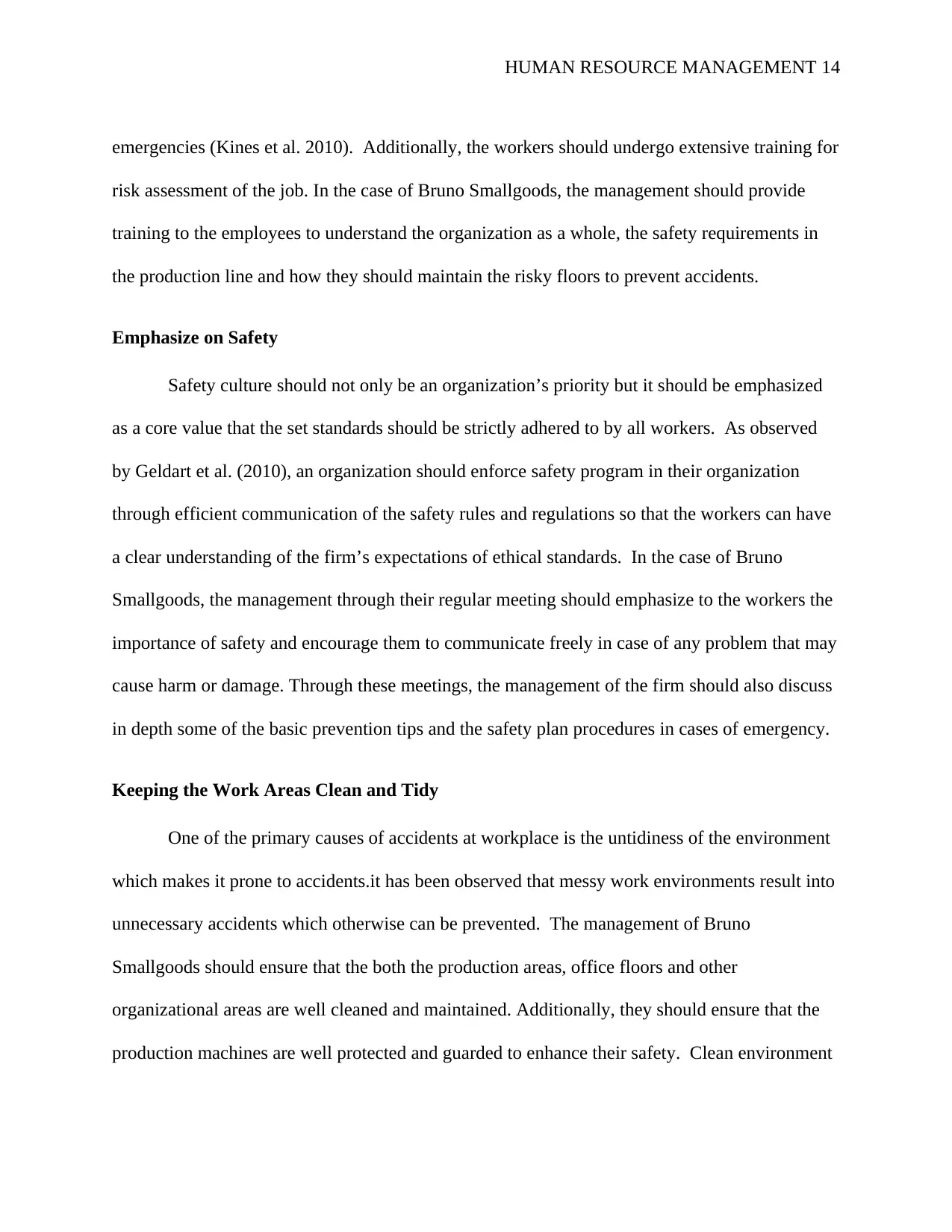
HUMAN RESOURCE MANAGEMENT 14
emergencies (Kines et al. 2010). Additionally, the workers should undergo extensive training for
risk assessment of the job. In the case of Bruno Smallgoods, the management should provide
training to the employees to understand the organization as a whole, the safety requirements in
the production line and how they should maintain the risky floors to prevent accidents.
Emphasize on Safety
Safety culture should not only be an organization’s priority but it should be emphasized
as a core value that the set standards should be strictly adhered to by all workers. As observed
by Geldart et al. (2010), an organization should enforce safety program in their organization
through efficient communication of the safety rules and regulations so that the workers can have
a clear understanding of the firm’s expectations of ethical standards. In the case of Bruno
Smallgoods, the management through their regular meeting should emphasize to the workers the
importance of safety and encourage them to communicate freely in case of any problem that may
cause harm or damage. Through these meetings, the management of the firm should also discuss
in depth some of the basic prevention tips and the safety plan procedures in cases of emergency.
Keeping the Work Areas Clean and Tidy
One of the primary causes of accidents at workplace is the untidiness of the environment
which makes it prone to accidents.it has been observed that messy work environments result into
unnecessary accidents which otherwise can be prevented. The management of Bruno
Smallgoods should ensure that the both the production areas, office floors and other
organizational areas are well cleaned and maintained. Additionally, they should ensure that the
production machines are well protected and guarded to enhance their safety. Clean environment
emergencies (Kines et al. 2010). Additionally, the workers should undergo extensive training for
risk assessment of the job. In the case of Bruno Smallgoods, the management should provide
training to the employees to understand the organization as a whole, the safety requirements in
the production line and how they should maintain the risky floors to prevent accidents.
Emphasize on Safety
Safety culture should not only be an organization’s priority but it should be emphasized
as a core value that the set standards should be strictly adhered to by all workers. As observed
by Geldart et al. (2010), an organization should enforce safety program in their organization
through efficient communication of the safety rules and regulations so that the workers can have
a clear understanding of the firm’s expectations of ethical standards. In the case of Bruno
Smallgoods, the management through their regular meeting should emphasize to the workers the
importance of safety and encourage them to communicate freely in case of any problem that may
cause harm or damage. Through these meetings, the management of the firm should also discuss
in depth some of the basic prevention tips and the safety plan procedures in cases of emergency.
Keeping the Work Areas Clean and Tidy
One of the primary causes of accidents at workplace is the untidiness of the environment
which makes it prone to accidents.it has been observed that messy work environments result into
unnecessary accidents which otherwise can be prevented. The management of Bruno
Smallgoods should ensure that the both the production areas, office floors and other
organizational areas are well cleaned and maintained. Additionally, they should ensure that the
production machines are well protected and guarded to enhance their safety. Clean environment
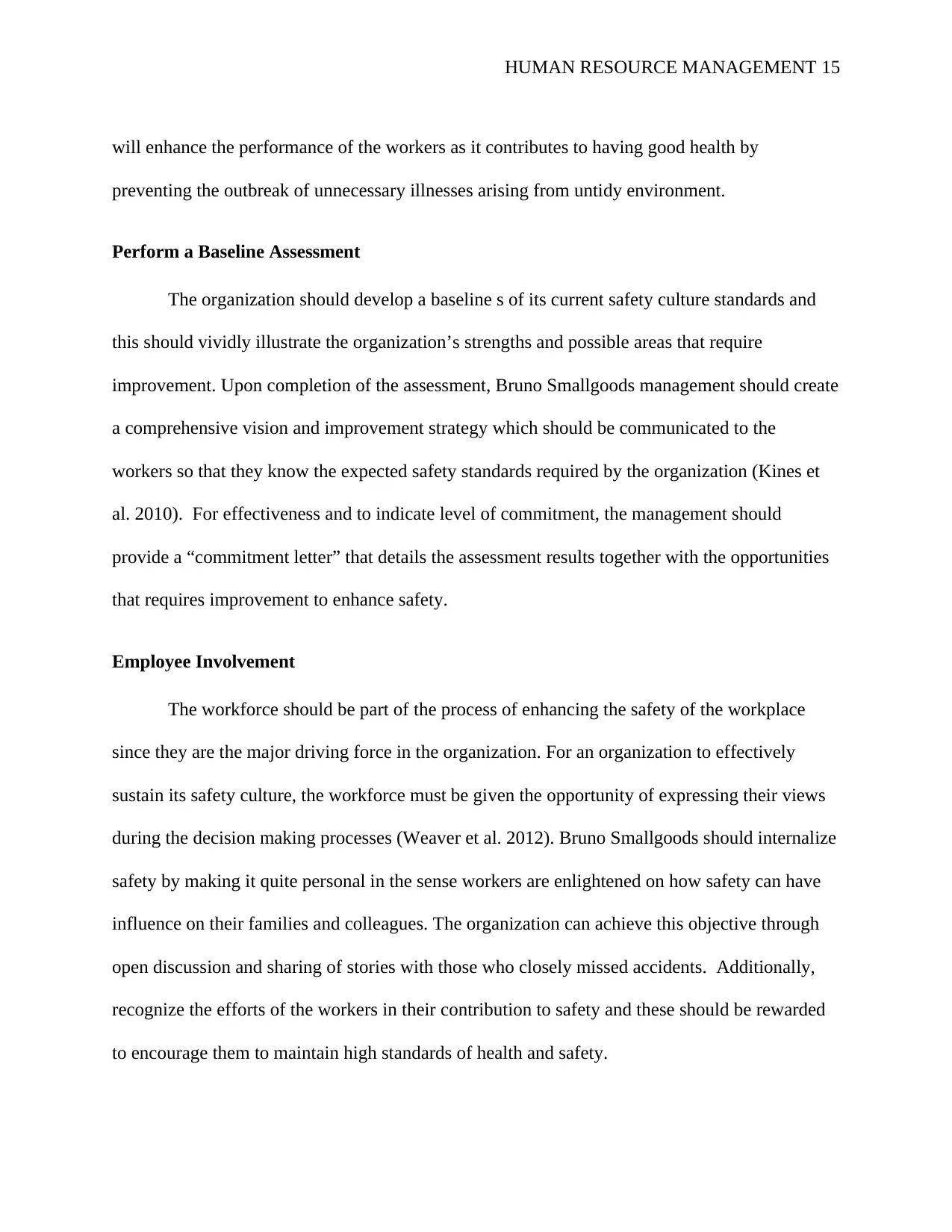
HUMAN RESOURCE MANAGEMENT 15
will enhance the performance of the workers as it contributes to having good health by
preventing the outbreak of unnecessary illnesses arising from untidy environment.
Perform a Baseline Assessment
The organization should develop a baseline s of its current safety culture standards and
this should vividly illustrate the organization’s strengths and possible areas that require
improvement. Upon completion of the assessment, Bruno Smallgoods management should create
a comprehensive vision and improvement strategy which should be communicated to the
workers so that they know the expected safety standards required by the organization (Kines et
al. 2010). For effectiveness and to indicate level of commitment, the management should
provide a “commitment letter” that details the assessment results together with the opportunities
that requires improvement to enhance safety.
Employee Involvement
The workforce should be part of the process of enhancing the safety of the workplace
since they are the major driving force in the organization. For an organization to effectively
sustain its safety culture, the workforce must be given the opportunity of expressing their views
during the decision making processes (Weaver et al. 2012). Bruno Smallgoods should internalize
safety by making it quite personal in the sense workers are enlightened on how safety can have
influence on their families and colleagues. The organization can achieve this objective through
open discussion and sharing of stories with those who closely missed accidents. Additionally,
recognize the efforts of the workers in their contribution to safety and these should be rewarded
to encourage them to maintain high standards of health and safety.
will enhance the performance of the workers as it contributes to having good health by
preventing the outbreak of unnecessary illnesses arising from untidy environment.
Perform a Baseline Assessment
The organization should develop a baseline s of its current safety culture standards and
this should vividly illustrate the organization’s strengths and possible areas that require
improvement. Upon completion of the assessment, Bruno Smallgoods management should create
a comprehensive vision and improvement strategy which should be communicated to the
workers so that they know the expected safety standards required by the organization (Kines et
al. 2010). For effectiveness and to indicate level of commitment, the management should
provide a “commitment letter” that details the assessment results together with the opportunities
that requires improvement to enhance safety.
Employee Involvement
The workforce should be part of the process of enhancing the safety of the workplace
since they are the major driving force in the organization. For an organization to effectively
sustain its safety culture, the workforce must be given the opportunity of expressing their views
during the decision making processes (Weaver et al. 2012). Bruno Smallgoods should internalize
safety by making it quite personal in the sense workers are enlightened on how safety can have
influence on their families and colleagues. The organization can achieve this objective through
open discussion and sharing of stories with those who closely missed accidents. Additionally,
recognize the efforts of the workers in their contribution to safety and these should be rewarded
to encourage them to maintain high standards of health and safety.
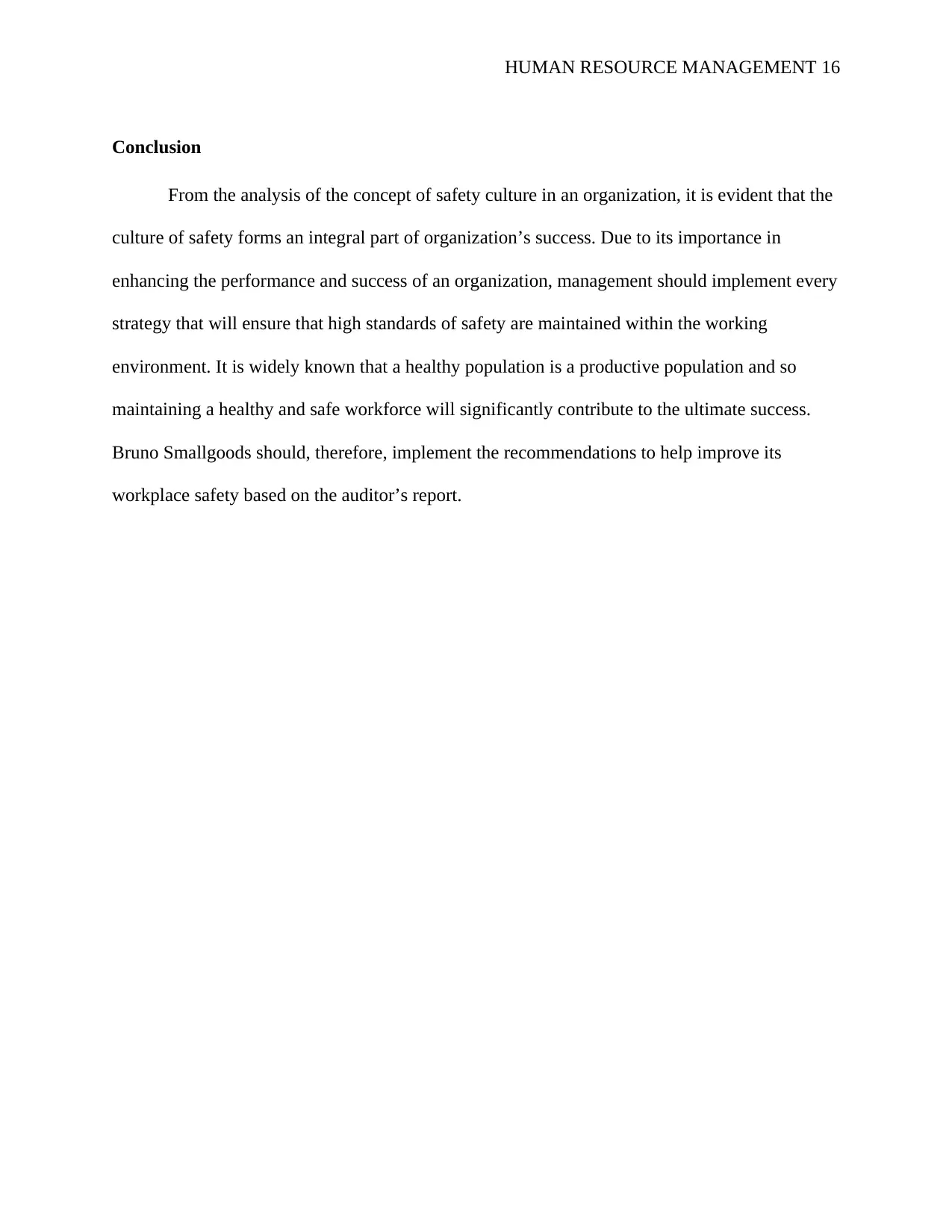
HUMAN RESOURCE MANAGEMENT 16
Conclusion
From the analysis of the concept of safety culture in an organization, it is evident that the
culture of safety forms an integral part of organization’s success. Due to its importance in
enhancing the performance and success of an organization, management should implement every
strategy that will ensure that high standards of safety are maintained within the working
environment. It is widely known that a healthy population is a productive population and so
maintaining a healthy and safe workforce will significantly contribute to the ultimate success.
Bruno Smallgoods should, therefore, implement the recommendations to help improve its
workplace safety based on the auditor’s report.
Conclusion
From the analysis of the concept of safety culture in an organization, it is evident that the
culture of safety forms an integral part of organization’s success. Due to its importance in
enhancing the performance and success of an organization, management should implement every
strategy that will ensure that high standards of safety are maintained within the working
environment. It is widely known that a healthy population is a productive population and so
maintaining a healthy and safe workforce will significantly contribute to the ultimate success.
Bruno Smallgoods should, therefore, implement the recommendations to help improve its
workplace safety based on the auditor’s report.
Secure Best Marks with AI Grader
Need help grading? Try our AI Grader for instant feedback on your assignments.

HUMAN RESOURCE MANAGEMENT 17
References
Bond, S.A., Tuckey, M.R. and Dollard, M.F., 2010. Psychosocial safety climate, workplace
bullying, and symptoms of posttraumatic stress. Organization Development Journal,
28(1), p.37.
Boxall, P. and Purcell, J., 2011. Strategy and human resource management. Palgrave Macmillan.
Bratton, J. and Gold, J., 2012. Human resource management: theory and practice. Palgrave
Macmillan.
Carayon, P., Hancock, P., Leveson, N., Noy, I., Sznelwar, L. and Van Hootegem, G., 2015.
Advancing a sociotechnical systems approach to workplace safety–developing the
conceptual framework. Ergonomics, 58(4), pp.548-564.
Geldart, S., Smith, C.A., Shannon, H.S. and Lohfeld, L., 2010. Organizational practices and
workplace health and safety: A cross-sectional study in manufacturing companies. Safety
Science, 48(5), pp.562-569.
Glendon, A.I., Clarke, S. and McKenna, E., 2016. Human safety and risk management. Crc
Press.
Guest, D.E., 2011. Human resource management and performance: still searching for some
answers. Human resource management journal, 21(1), pp.3-13.
Hale, A. and Borys, D., 2013. Working to rule or working safely? Part 2: The management of
safety rules and procedures. Safety science, 55, pp.222-231.
Hart, S.M., 2010. Self-regulation, corporate social responsibility, and the business case: Do they
work in achieving workplace equality and safety?. Journal of Business Ethics, 92(4),
pp.585-600.
Hymel, P.A., Loeppke, R.R., Baase, C.M., Burton, W.N., Hartenbaum, N.P., Hudson, T.W.,
McLellan, R.K., Mueller, K.L., Roberts, M.A., Yarborough, C.M. and Konicki, D.L.,
References
Bond, S.A., Tuckey, M.R. and Dollard, M.F., 2010. Psychosocial safety climate, workplace
bullying, and symptoms of posttraumatic stress. Organization Development Journal,
28(1), p.37.
Boxall, P. and Purcell, J., 2011. Strategy and human resource management. Palgrave Macmillan.
Bratton, J. and Gold, J., 2012. Human resource management: theory and practice. Palgrave
Macmillan.
Carayon, P., Hancock, P., Leveson, N., Noy, I., Sznelwar, L. and Van Hootegem, G., 2015.
Advancing a sociotechnical systems approach to workplace safety–developing the
conceptual framework. Ergonomics, 58(4), pp.548-564.
Geldart, S., Smith, C.A., Shannon, H.S. and Lohfeld, L., 2010. Organizational practices and
workplace health and safety: A cross-sectional study in manufacturing companies. Safety
Science, 48(5), pp.562-569.
Glendon, A.I., Clarke, S. and McKenna, E., 2016. Human safety and risk management. Crc
Press.
Guest, D.E., 2011. Human resource management and performance: still searching for some
answers. Human resource management journal, 21(1), pp.3-13.
Hale, A. and Borys, D., 2013. Working to rule or working safely? Part 2: The management of
safety rules and procedures. Safety science, 55, pp.222-231.
Hart, S.M., 2010. Self-regulation, corporate social responsibility, and the business case: Do they
work in achieving workplace equality and safety?. Journal of Business Ethics, 92(4),
pp.585-600.
Hymel, P.A., Loeppke, R.R., Baase, C.M., Burton, W.N., Hartenbaum, N.P., Hudson, T.W.,
McLellan, R.K., Mueller, K.L., Roberts, M.A., Yarborough, C.M. and Konicki, D.L.,
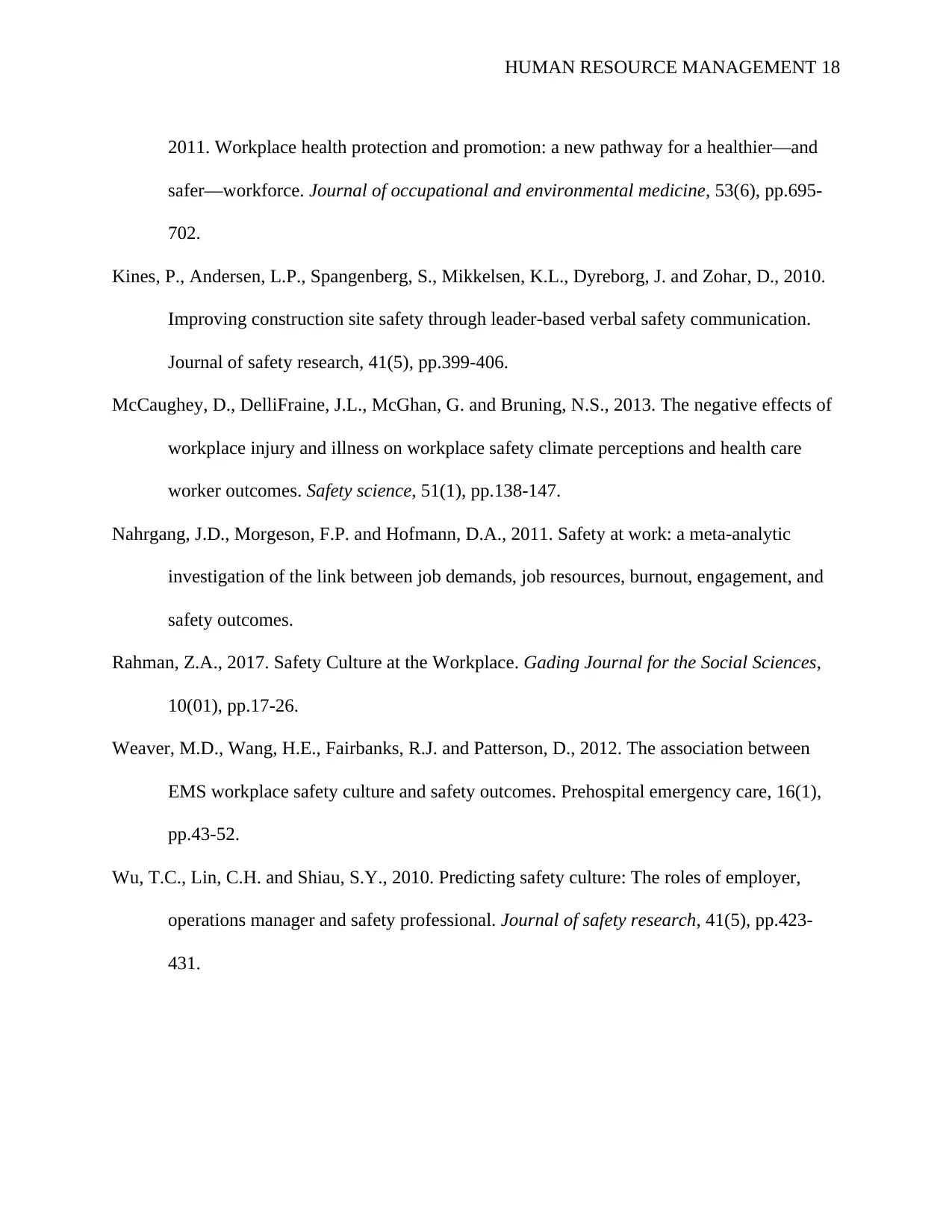
HUMAN RESOURCE MANAGEMENT 18
2011. Workplace health protection and promotion: a new pathway for a healthier—and
safer—workforce. Journal of occupational and environmental medicine, 53(6), pp.695-
702.
Kines, P., Andersen, L.P., Spangenberg, S., Mikkelsen, K.L., Dyreborg, J. and Zohar, D., 2010.
Improving construction site safety through leader-based verbal safety communication.
Journal of safety research, 41(5), pp.399-406.
McCaughey, D., DelliFraine, J.L., McGhan, G. and Bruning, N.S., 2013. The negative effects of
workplace injury and illness on workplace safety climate perceptions and health care
worker outcomes. Safety science, 51(1), pp.138-147.
Nahrgang, J.D., Morgeson, F.P. and Hofmann, D.A., 2011. Safety at work: a meta-analytic
investigation of the link between job demands, job resources, burnout, engagement, and
safety outcomes.
Rahman, Z.A., 2017. Safety Culture at the Workplace. Gading Journal for the Social Sciences,
10(01), pp.17-26.
Weaver, M.D., Wang, H.E., Fairbanks, R.J. and Patterson, D., 2012. The association between
EMS workplace safety culture and safety outcomes. Prehospital emergency care, 16(1),
pp.43-52.
Wu, T.C., Lin, C.H. and Shiau, S.Y., 2010. Predicting safety culture: The roles of employer,
operations manager and safety professional. Journal of safety research, 41(5), pp.423-
431.
2011. Workplace health protection and promotion: a new pathway for a healthier—and
safer—workforce. Journal of occupational and environmental medicine, 53(6), pp.695-
702.
Kines, P., Andersen, L.P., Spangenberg, S., Mikkelsen, K.L., Dyreborg, J. and Zohar, D., 2010.
Improving construction site safety through leader-based verbal safety communication.
Journal of safety research, 41(5), pp.399-406.
McCaughey, D., DelliFraine, J.L., McGhan, G. and Bruning, N.S., 2013. The negative effects of
workplace injury and illness on workplace safety climate perceptions and health care
worker outcomes. Safety science, 51(1), pp.138-147.
Nahrgang, J.D., Morgeson, F.P. and Hofmann, D.A., 2011. Safety at work: a meta-analytic
investigation of the link between job demands, job resources, burnout, engagement, and
safety outcomes.
Rahman, Z.A., 2017. Safety Culture at the Workplace. Gading Journal for the Social Sciences,
10(01), pp.17-26.
Weaver, M.D., Wang, H.E., Fairbanks, R.J. and Patterson, D., 2012. The association between
EMS workplace safety culture and safety outcomes. Prehospital emergency care, 16(1),
pp.43-52.
Wu, T.C., Lin, C.H. and Shiau, S.Y., 2010. Predicting safety culture: The roles of employer,
operations manager and safety professional. Journal of safety research, 41(5), pp.423-
431.
1 out of 18
Related Documents
Your All-in-One AI-Powered Toolkit for Academic Success.
+13062052269
info@desklib.com
Available 24*7 on WhatsApp / Email
![[object Object]](/_next/static/media/star-bottom.7253800d.svg)
Unlock your academic potential
© 2024 | Zucol Services PVT LTD | All rights reserved.




